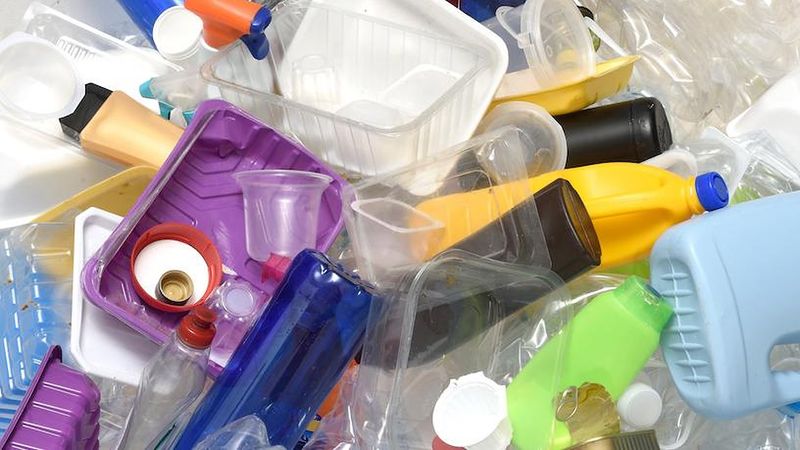An Upcycling Solution to Mixed Plastics Rooted in New Chemistry
Polymer chemists at Columbia University and Colorado State University have developed a fundamental new chemistry that seeds a creative, chemistry-based solution to the challenge of recycling mixed-use plastics.

Photo Credit: Josep Curto/Shutterstock.com
Plastics are everywhere in our daily lives, but not all plastics are created equal – far from it. Take, for instance, polyethylene terephthalate, which is used to make plastic soda bottles and clothing fibers and is a key contributor to plastic pollution. Then there’s high-density polyethylene, from which shampoo bottles, milk jugs, and cutting boards are derived. And don’t forget polystyrene for packaging, or low-density polyethylene, which gives us cling wrap and grocery bags.
All of these are plastics, which are the most widely used types of polymers – macromolecules made of repeating units of small molecules called monomers. Post-consumer plastics are almost always collected as a mixed stream of waste, and products are often manufactured from two or more types of plastics.
The bad news about collecting them in this way is that these items, though all “plastics,” are chemically and physically incompatible, and there’s no good industrial method for reusing or re-processing them into other, useful products. That’s why most of those “recyclables” that many of us throw into recycle bins every week are going to a landfill. Even after careful sorting and separation into individual plastics, mechanical recycling usually yields inferior products, termed down-cycling.
Polymer chemists at Columbia University and Colorado State University, have long been leaders in finding ways to tackle the environmental problems humans have created with plastics waste. Now, they’ve come up with fundamental new chemistry that seeds a creative, chemistry-based solution to the challenge of recycling mixed-use plastics.
Led by Columbia Professors Tomislav Rovis and Sanat Kumar, and collaborators at Colorado State University, the team has devised a new chemical strategy that delivers specifically designed small molecules called universal dynamic crosslinkers into mixed plastic streams. These crosslinkers transform a formerly immiscible muck into a viable new set of polymers, which can be turned into new, higher-value, re-processable materials, a process known as upcycling. Their work is published in the journal, Nature.
When heated and processed together with the dynamic crosslinkers added in small amounts, the mixed plastics are made compatible with each other through in-situ formation of a new material, called a multiblock copolymer.
Kumar, the Bykhovsky Professor of Chemical Engineering at Columbia Engineering likened the block copolymers to soap molecules, which make water compatible with oily dirt molecules. “In a similar way, these new types of dynamically formed ‘soaps,’ i.e. the block copolymers, compatibilize mixed plastics and make them usable as a new kind of material with useful properties.”
This new method of upcycling, which does not involve deconstructing or reconstructing any of the original polymers, introduces a potential solution for recapturing materials and energy endowed in post-consumer mixed plastics that typically end up in landfills.
These new types of dynamically formed ‘soaps,’ i.e. the block copolymers, compatibilize mixed plastics and make them usable as a new kind of material with useful properties.
- SANAT KUMAR, MICHAEL BYKHOVSKY AND CHARO GONZALEZ-BYKHOVSKY PROFESSOR OF CHEMICAL ENGINEERING
The team designed their crosslinkers and tested them on a variety of plastics including samples of mixed polyethylene zip-lock bags and polylactide cups without prior purification or removal of additives or dyes, which are typically present in post-consumer plastic products. They combined their experiments with modeling studies to verify that the crosslinkers induce the formation of new multiblock copolymers.
“The system is so efficient, it compatibilizes three different polymers into a single new material,” said Rovis, the Samuel Latham Mitchill Professor of Chemistry at Columbia.
The researchers posit that their new strategy could help achieve the ultimate goal of reusing mixed plastic waste over multiple use cycles, Chen said. “A key barrier is cost; we are talking about millions of tons of plastic waste, and you have to consider how many of these dynamic crosslinkers you need, although we currently need only less than 5% of the weight of the plastics in our upcycling process. Like many fundamental discoveries made in history, practical obstacles exist at the very beginning, but we are very excited about future potential.”
Learn more about Sanat Kumar and his research
Sanat Kumar's work has reshaped the way researchers think about polymers, particularly in confined geometries. And, as both an engineer and an educator he's reshaping how to think about the problems we tackle and their impact on society.
